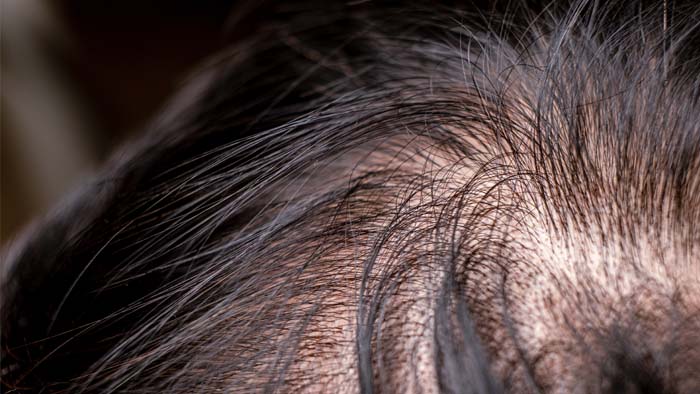Now Reading: Hair Loss in Women – Understanding CCCA: Central Centrifugal Cicatricial Alopecia
-
01
Hair Loss in Women – Understanding CCCA: Central Centrifugal Cicatricial Alopecia
Hair Loss in Women – Understanding CCCA: Central Centrifugal Cicatricial Alopecia

Introduction
Hair has always been more than just hair. Across cultures and history, it’s been a symbol of beauty, strength, spirituality, and identity. That’s why conditions that cause hair loss often strike deeper than the scalp—they affect confidence, self-expression, and emotional well-being.
Among the many forms of hair loss, Central Centrifugal Cicatricial Alopecia (CCCA) is one of the most misunderstood, underdiagnosed, and devastating for those who live with it. Most common in women of African descent, CCCA is a type of scarring alopecia—meaning it permanently destroys hair follicles, leaving behind areas of smooth, shiny scalp where hair cannot regrow.
While it may begin subtly, with thinning or breakage at the crown of the head, CCCA can progress over time to significant, permanent hair loss. For many women, this isn’t just a cosmetic issue—it’s a deeply personal battle tied to identity, culture, and health.
In this in-depth feature, we’ll explore what CCCA is, who it affects, why it develops, and what can be done to prevent, manage, and cope with this condition.
What Is CCCA?
CCCA stands for Central Centrifugal Cicatricial Alopecia. Let’s break down the name:
- Central – It usually begins in the center of the scalp (the crown).
- Centrifugal – It spreads outward in a circular pattern.
- Cicatricial – It involves scarring, meaning the follicles are destroyed and replaced with scar tissue.
- Alopecia – The medical word for hair loss.
This type of hair loss differs from more familiar conditions like androgenetic alopecia (pattern baldness) or alopecia areata (autoimmune hair loss) because once the follicles are scarred, they cannot produce hair again. That’s why early detection and intervention are absolutely critical.
Who Does It Affect?
Research shows that CCCA disproportionately affects women of African descent, though it can occur in men and in people of other ethnicities.
A study published in the Journal of the American Academy of Dermatology estimated that up to 15% of African American women may be affected—making it the most common form of scarring alopecia in this group.
The average age of diagnosis is often in the 30s or 40s, but many women report symptoms much earlier. Because it tends to run in families, there may be a genetic predisposition.
Signs and Symptoms
CCCA often begins quietly, which makes it easy to miss in its early stages. Some common signs include:
- Thinning or hair breakage at the crown (the central scalp).
- Gradual spreading outward of hair loss in a circular or oval pattern.
- Tenderness, itching, or burning in the affected area.
- Shiny or smooth scalp patches where hair no longer grows.
- Small bumps or scaling (in some cases, inflammation can be seen).
Because symptoms like itching and scaling may resemble dandruff or psoriasis, some women dismiss them until the hair loss becomes noticeable. By then, significant scarring may already have occurred.
Why Does CCCA Happen?
The exact cause of CCCA remains unclear, but research points to multiple contributing factors:
1. Genetic Predisposition
Studies have identified mutations in the PADI3 gene, which plays a role in hair shaft formation. This suggests that some women may be genetically more susceptible.
2. Hair Care Practices
Many dermatologists believe that styling practices common in Black communities—such as frequent use of relaxers, chemical straightening, hot combs, tight braids, and weaves—may play a role. These practices put stress on the scalp, leading to inflammation and follicle damage. However, it’s important to note that not all women who use these styles develop CCCA, and some women who avoid them still do.
3. Inflammation and Immune Response
Like other scarring alopecias, CCCA appears to involve an inflammatory process where the body’s immune system attacks the hair follicle, leading to destruction and scarring.
4. Hormonal and Metabolic Links
CCCA has been associated with conditions such as type 2 diabetes, uterine fibroids, and metabolic syndrome. This suggests that systemic health may influence its development.
Diagnosis
Because CCCA can mimic other scalp conditions, professional diagnosis is essential. Dermatologists typically use:
- Clinical examination – Visual inspection of the scalp pattern.
- Trichoscopy (scalp microscopy) – To assess follicle structure and inflammation.
- Scalp biopsy – A small sample is taken to confirm the presence of follicle scarring.
Early and accurate diagnosis allows for timely treatment, which can help preserve existing hair and slow progression.
Treatment Options
While there is no cure for CCCA, treatment focuses on stopping progression, reducing symptoms, and preserving hair that remains.
1. Anti-Inflammatory Medications
- Topical steroids (creams, ointments, solutions) applied to the scalp.
- Intralesional corticosteroid injections (injected directly into the scalp).
- Oral anti-inflammatories (such as doxycycline, which also has anti-inflammatory properties).
2. Immune-Modulating Treatments
In some cases, dermatologists may prescribe drugs that alter the immune response, such as hydroxychloroquine.
3. Scalp and Hair Care Changes
- Avoiding chemical relaxers, hot combs, or harsh heat.
- Reducing traction from braids, weaves, or tight ponytails.
- Switching to gentle, natural styles.
- Using mild shampoos and scalp-soothing oils.
4. Regrowth Support
While scarred follicles cannot regrow hair, medications like minoxidil may help thicken remaining hair and support regrowth in unaffected follicles.
5. PRP (Platelet-Rich Plasma) Therapy
A newer and increasingly popular option for certain types of hair loss is Platelet-Rich Plasma (PRP) therapy. This treatment involves drawing a small amount of the patient’s own blood, spinning it in a centrifuge to concentrate the platelets, and then injecting this plasma back into the scalp.
Platelets contain growth factors that may help stimulate hair follicle activity, improve blood supply, and encourage healthier hair growth. While research on PRP for CCCA specifically is still limited, some dermatologists are using it as part of a combined treatment plan to strengthen existing follicles and slow down hair loss progression.
It’s important to note that PRP is most effective on active, non-scarred follicles. Once scarring has destroyed the follicle, PRP cannot regrow hair in that area. However, for patients in the early or middle stages of CCCA, PRP may offer additional support in preserving remaining hair.
6. Surgical Options
In advanced cases, hair transplantation may be considered, but success is limited if scarring is widespread.
Emotional and Psychological Impact
For many women, hair loss isn’t “just hair.” It’s tied to self-image, identity, and cultural pride. The emotional burden of CCCA is often profound.
- Self-Esteem: Many women feel embarrassed, anxious, or avoid social situations.
- Mental Health: Depression and anxiety are not uncommon.
- Cultural Pressure: In communities where hair is seen as a crown, women may feel they’ve lost part of themselves.
Support from therapists, support groups, and communities (both online and in person) can make a tremendous difference.
Coping and Living With CCCA
Living with CCCA requires both medical management and emotional resilience. Some strategies include:
- Early Dermatology Visits: If you notice thinning at the crown, don’t wait.
- Protective Styling: Choose low-tension styles that minimize scalp stress.
- Scalp Care: Keep the scalp clean and moisturized.
- Headwear Confidence: Scarves, wigs, and turbans can be stylish and empowering.
- Community Support: Connecting with others who share the experience helps reduce isolation.
Prevention and Awareness
Since genetics play a role, prevention may not always be possible. However, awareness of risk factors and gentle hair care practices may help reduce the likelihood or slow progression.
- Limit harsh chemicals and high heat.
- Avoid styles that pull tightly on the scalp.
- Pay attention to scalp symptoms like itching or tenderness.
- Schedule regular dermatology checkups if you’re at risk.
Stories From the Community
One of the most powerful ways to understand CCCA is through the voices of those affected.
- “I thought it was just breakage from braids, but then I noticed the patch kept growing. By the time I saw a dermatologist, it was too late for that area to regrow.” – Monique, 42
- “Wearing wigs gave me back my confidence, but what helped most was joining an online support group. I realized I wasn’t alone.” – Angela, 36
- “CCCA runs in my family. My mother had it, and now I do too. But catching it early has made all the difference.” – Denise, 29
These stories underscore the importance of awareness, early action, and community.
Looking Ahead: Research and Hope
Researchers are continuing to explore the genetic, hormonal, and inflammatory aspects of CCCA. With growing attention to diversity in dermatology, new treatments may emerge in the coming years. Clinical trials are investigating:
- Novel anti-inflammatory medications.
- Stem cell and regenerative therapies.
- Better surgical approaches for scarring alopecia.
As awareness increases, so does the hope for improved care and outcomes.
Conclusion
Central Centrifugal Cicatricial Alopecia is more than a medical condition—it’s a personal journey that intertwines health, heritage, and identity. For too long, CCCA has remained underdiagnosed and undertreated, leaving women to struggle silently with permanent hair loss.
But knowledge is power. Understanding the signs, seeking help early, making gentle hair care choices, and connecting with supportive communities can all make a difference.
At Good Day, Good Health, we believe that wellness isn’t just about living longer—it’s about living fully, with confidence and dignity. By shining a light on CCCA, we hope to empower readers to take charge of their scalp health, advocate for themselves, and know they are not alone.



